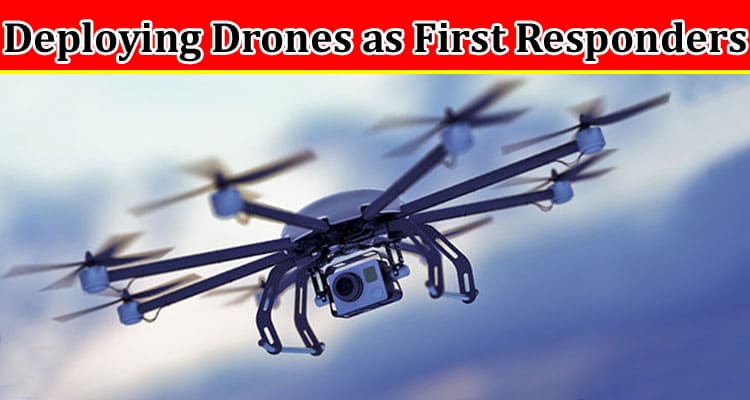This article will give an in-depth exploration of deploying drones as first responders. This innovative approach has revolutionized emergency response capabilities for law enforcement agencies, offering real-time situational awareness, enhanced response times, and increased safety for officers and civilians. Police drones are now crucial in various law enforcement operations, allowing officers to quickly assess critical situations from a bird’s-eye view. By integrating these drones into their toolkit, law enforcement agencies have gained a powerful advantage in protecting and serving their communities effectively. keep reading to delve into how these drones transform emergency response strategies and the benefits they bring to the table.
Unveiling the Power of Police Drones:
Law enforcement agencies have found using drones as first responders to be a valuable asset.With advanced features such as high-definition cameras, thermal imaging, and AI capabilities, police drones can swiftly provide a comprehensive aerial view of unfolding situations. This real-time intelligence empowers officers to make informed decisions more effectively and efficiently. Drones act as additional sets of eyes in the sky, giving officers a tactical advantage and critical insights into various emergency scenarios.
Enhanced Situational Awareness from Above:
The aerial perspective offered by police drones is particularly advantageous in various scenarios. During high-speed car chases, drones provide an unprecedented view of the situation, enabling officers to monitor the pursuit from a safe distance and assess potential risks. In missing person searches conducted in dense woods or urban areas, drones can survey vast landscapes, significantly increasing the chances of locating the individual quickly. Moreover, during large-scale protests or public gatherings, drones offer an invaluable vantage point for monitoring crowd dynamics, aiding law enforcement in maintaining order and ensuring public safety. The ability to view incidents from above grants officers an understanding of the entire picture, contributing to better decision-making and more effective resource allocation.
Minimizing Officer Risk:
One of the most significant advantages of deploying drones as first responders is the ability to mitigate risks faced by police officers in hazardous situations. In hostage crises or armed standoffs, drones can gather real-time intelligence about the environment before officers enter, allowing them to devise safer and more effective intervention strategies. When responding to building fires or other potentially hazardous scenarios, drones offer a means to assess the situation without endangering human lives, ensuring officers approach the scene with enhanced knowledge and preparedness. By reducing officers’ exposure to dangerous situations, drones protect law enforcement personnel while enabling them to execute their duties effectively.
Rapid Response and Quick Deployment:
Time is often of the essence in emergencies, and the rapid deployment of drones as first responders can be a game-changer. Unlike traditional response methods, which may require significant time and resources to arrive at the scene, police drones can be launched swiftly from patrol car trunks. Their agility and speed allow them to reach the target location within moments, providing vital support and intelligence to officers in the field. With immediate access to aerial data, officers can quickly assess the situation and respond accordingly, potentially saving precious minutes that can be critical in life-threatening emergencies.
Seamless Integration with Ground Operations:
For drones to serve as effective first responders, seamless integration with ground operations is critical. Close coordination between drone operators and officers on the ground ensures that the real-time information gathered by the drones is effectively utilized in decision-making. This collaborative approach allows officers to leverage drones’ aerial insights to develop more efficient and coordinated response plans. Drone operators act as an extension of the police team, providing live feeds and critical information to ground units, enabling a more comprehensive and well-coordinated response to incidents.
Training and Expertise for Effective Deployment:
Deploying drones as first responders necessitate specialized training for drone operators and ground personnel. While drone operating may seem straightforward, skilled operators must handle diverse emergency scenarios effectively. Training includes:
- Simulated emergencies.
- Emphasizing decision-making under pressure.
- Situational awareness.
- Adherence to legal and ethical guidelines.
This comprehensive training equips drone operators to navigate complex emergencies with efficiency and accuracy. Additionally, ground personnel receive training on effectively collaborating with drone operators, understanding the capabilities of the drones, and utilizing the data they provide to enhance their response strategies.
Navigating Legal and Ethical Considerations:
Using drones as first responders presents a host of legal and ethical considerations. Privacy, data storage, and public perception concerns require transparency from law enforcement agencies. Engaging with the community and addressing their concerns is crucial to building trust in drone operations. Adherence to existing legal frameworks and regulations ensures that drone deployment benefits do not compromise individual rights and privacy. Police departments must be proactive in educating the public about their drone programs, assuring them that the use of drones is governed by strict protocols that prioritize both public safety and privacy.
Expanding Capabilities through Innovation:
The landscape of drone technology continues to evolve, opening up new possibilities for law enforcement agencies. Advancements in artificial intelligence, drone autonomy, and extended flight times present exciting opportunities to expand the application of police drones. From automated emergency response systems to package delivery during emergencies, drones hold the potential to transform emergency services and enhance community safety. By staying updated with technological advancements, police departments can continually explore new ways to leverage drone capabilities for the benefit of public safety.
Future of Drones as First Responders:
As drones continue to prove their effectiveness as first responders, it is evident that they will play an integral role in future law enforcement operations. Continued advancements in technology will likely expand the capabilities of police drones, allowing for even more sophisticated applications. The future may see the integration of drones with AI-powered emergency response systems, enabling them to assess and respond to incidents autonomously. However, as the use of drones evolves, maintaining ethical standards, fostering community trust, and addressing privacy concerns will remain vital considerations to ensure that deploying drones as first responders continue to be a beneficial and responsible practice in safeguarding communities and public safety.
Conclusion:
Integrating police drones as first responders has ushered in a new era of emergency response capabilities for law enforcement agencies. From enhanced situational awareness to rapid deployment and risk reduction for officers, police drones offer numerous advantages in critical situations. As technology progresses, law enforcement agencies must continue to balance leveraging drone capabilities and addressing ethical and legal considerations. By doing so, deploying police drones as first responders will continue to be a valuable asset in ensuring the safety and security of communities and upholding the principles of public service. As we move into the future, it is crucial for law enforcement agencies to remain adaptive, embracing innovation while maintaining a steadfast commitment to public safety and community trust.





